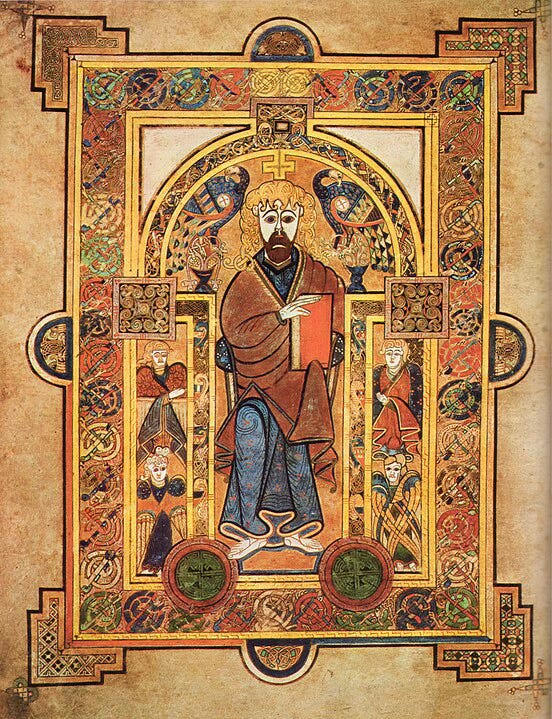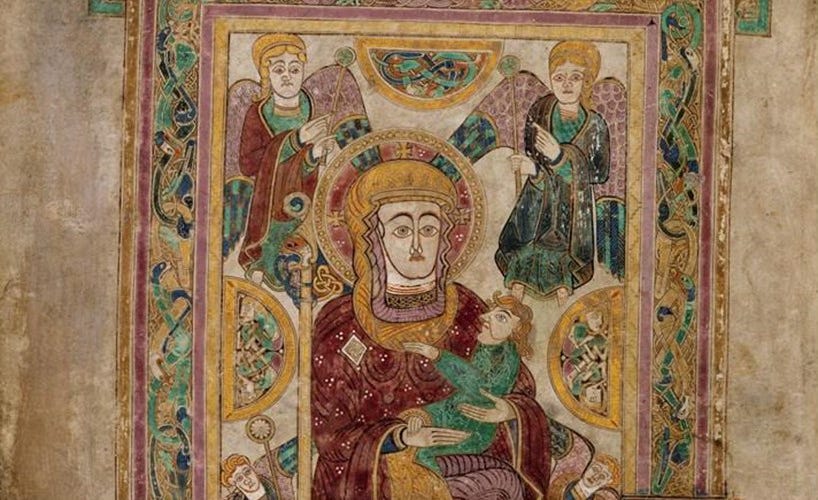Finding Joy In the Book of Kells
On Saturday at the Spirituality 101 webinar, I encouraged participants to look at the Book of Kells online, choose an image, and use it as a focal point for reflection. I also included a couple of colouring templates from the Book of Kells for people to colour during their time of reflection. It was a very enjoyable exercise, but as one participant commented “The colours are nothing like the real thing.” The Book of Kells also features in my upcoming Celtic Advent devotional Celtic Advent: Following An Unfamiliar Path, which should be amiable for preorder at the beginning of October and ready to be shipped by the middle of October. I have been giving paid subscribers a preview of many of the reflections but thought I would give all of you a glimpse with this reflection on the Book of Kells
I will never forget my visit to the library at Trinity College Dublin. In a room kept dim to preserve it a see-through case holds a masterpiece, one of the art wonders of the world.. This is the Book of Kells, the richest, most copiously illuminated manuscript of the four gospels in the Celtic style that still survives. It may have been created by St Columba on the island of Iona, was probably removed by the monks when they fled the Viking raids and taken to the Abbey of Kells which itself was raided repeatedly. The fact that most of it survived is almost miraculous. It was stolen and buried for three months, then passed from family to family and place to place until Charles II presented it to Trinity College in 1661.
These illuminated manuscripts were special even at the time of their creation. Every copy of every book produced for many centuries was made in a monastery scriptorium. Monks everywhere could write well enough to make copies of documents, but not every monastery could undertake the production of copies of books, an activity that required specialist skills. Even fewer monasteries had the expertise and artistry to undertake the production of highly decorated books like The Book of Kells and others that still exist including The Book of Durrow and the Lindisfarne Gospels. It is no wonder that so much effort was made to preserve them.
The beauty, symbolism and artistry of Celtic illuminated manuscripts like the Book of Kells is breathtaking, something to marvel at, priceless artifacts that are a joy to look at. I can imagine the monks hunched over the vellum, pin pricking guidelines for the text; lettering verses with iron-gall ink; illuminating pages with costly pigments and gold leaf—still vibrant centuries later. Each one was composed of beautiful text, written in the most careful and elegant hand, along with intricate borders, of Celtic knot work, spiraling vines, interweaving images of animals and birds, some realistic, some twisted and fantastical all of it embellished, or illuminated, with shining sections of precious gold leaf.
The words IN PRINCIPIO ERAT VERBUM ET VERBUM “In the beginning was the Word, and the Word was with God,” the opening words of the Gospel of John, is a particularly impressive opening to any piece of writing. The rich ornateness of the ornamentation captivates the eye and can hold one’s attention for hours. Not surprising as The Gospel of John was the favourite of the Celtic Christians.
Probably the greatest joy of the Book of Kells is the illuminated initial letters scattered with generous abandon through every page of the text. Their whimsical nature gives a sense of the delight the monks must have found in crafting them. Even small letters in the middle of a line are embellished with an extra twirl filled with contrasting colours, and open spaces at the end of a sentence are filled with stars, or fish or birds. Maybe these speak of the fun loving nature of the monks too.
Unfortunately the Advent story does not really feature in The Book of Kells, though Christmas does. There is only one depiction of a woman in the entire manuscript. It is the earliest surviving image of Mary and the Christ child in Western manuscript art. In contrast to the biblical description of Mary as a humble peasant, here she is depicted as an empress, enthroned and wearing royal clothing, an indication of how the impressions of her changed over the centuries. She is surrounded by four ‘courtiers’, in this case angels. Jesus is seated on her lap, with his hand placed on her clearly visible breast – an allusion to milk of Christian instruction, and also perhaps the fountain of life. The elaborate frame around the image is perhaps an allusion to its ultimate source.
I love to paint on rocks, and at times have tried to copy some of the less intricate patterns of the Book of Kells onto my stones. First I create a pattern with pencil, a consuming process requiring much erasing and repositioning. Then I outline the pattern with my paint pens and lastly fill in the resulting design with vibrant colours. It is a process of joy, and gives me a little glimpse into the delight the monks must have felt as they worked on their far more elaborate illuminations.
Reflection
The Book of Kells can now be viewed online for free. Scroll down the images until you find one that catches your attention. Spend a few minutes gazing at the image. Let your eyes rest on the characters and objects. Note your feelings as you examine the whole of the work. Write down what you are sensing. Now look at the image again, particularly at the details of the intricate embellishments. Does something new catch your attention. Keep your eyes focused on that for a couple of minutes and allow God to speak to you through the image. Write down your impressions. End with prayer.
God of every beautiful thing,
Give us eyes to see the wonder,
Of your world,
Let it disrupt our days with sacred pauses,
So that we marvel,
Not just at majestic mountains
And sweeping vistas,
But at the sparks of mystery
Carved in every ordinary thing,
That fills this earth
With your glory.
Let our hearts swell with delight,
At every wrinkled face made in God’s image,
Let us glory in the divine light
Enlivening every humdrum moment,
With the joy of your presence.




Hi Christine,
Thank you for this beautiful reflection on the Book of Kells and the prayer given at the end. Unfortunately I was not able to open the link to view it. This was the error code I received: HTTP ERROR 400. Blessings, Margie